BCO5501 Assignment 2: Business Process Management Conference Review
VerifiedAdded on 2023/06/04
|6
|1924
|92
Report
AI Summary
This report analyzes research papers presented at the 13th through 15th International Conferences on Business Process Management (BPM), focusing on the evolution and impact of BPM in various business contexts. The analysis highlights the increasing significance of BPM in improving business performance, especially with advancements in IT systems. The report examines the BPM lifecycle, including process design, modeling, execution, monitoring, optimization, and re-engineering, emphasizing the role of IT in automating and enhancing these processes. It also discusses the use of BPM frameworks, the impact of IT systems in implementation, and the importance of continuous improvement. The report identifies the critical components of technology-enabled BPM, and the limitations of the research papers, while concluding with the need for aligning BPM with business objectives. The research paper also emphasizes the importance of adapting business policies to accommodate the changes required for BPM implementation. The paper also provides insights into the necessity of re-engineering processes when optimization fails to achieve desired results.
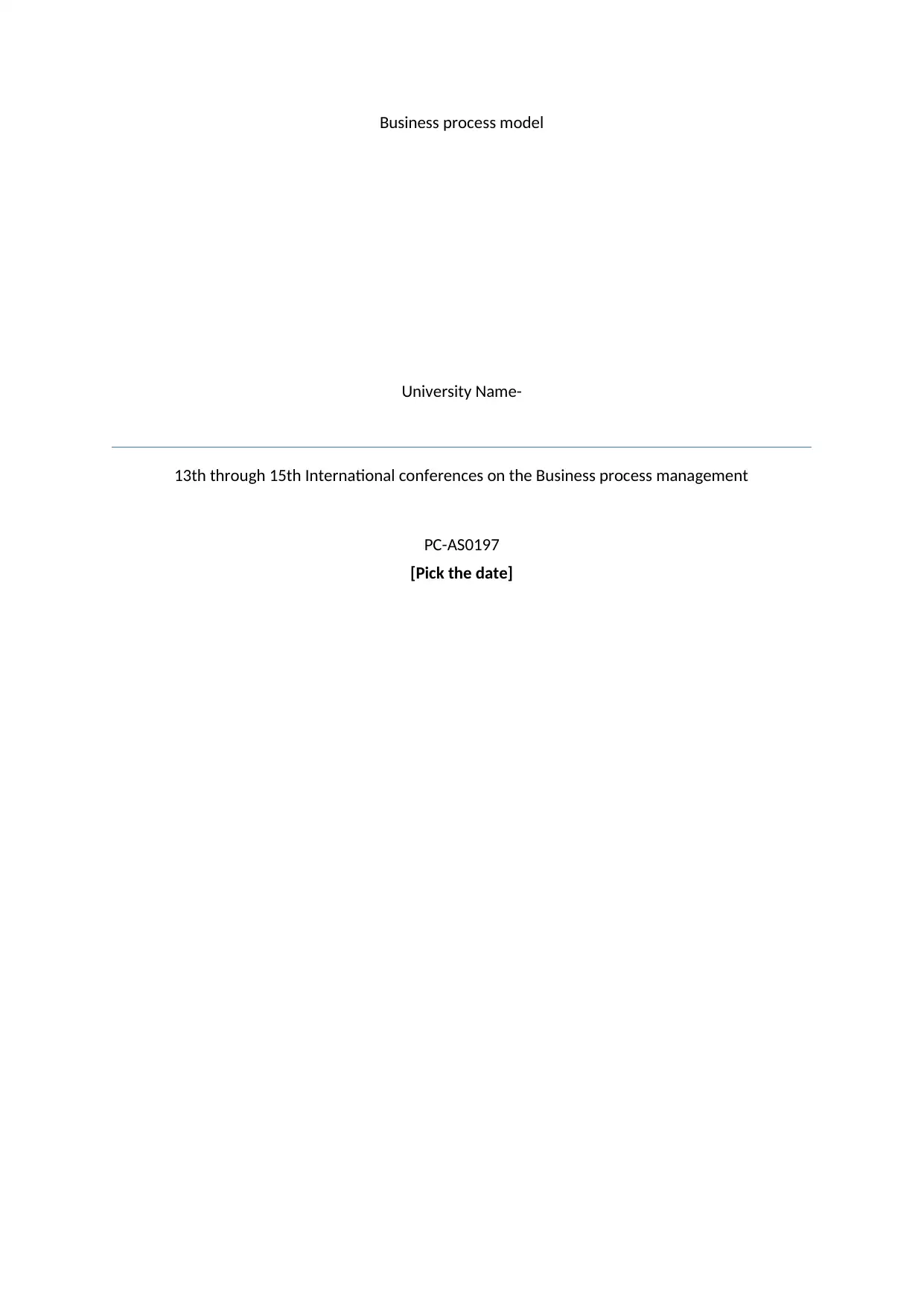
Business process model
University Name-
13th through 15th International conferences on the Business process management
PC-AS0197
[Pick the date]
University Name-
13th through 15th International conferences on the Business process management
PC-AS0197
[Pick the date]
Paraphrase This Document
Need a fresh take? Get an instant paraphrase of this document with our AI Paraphraser
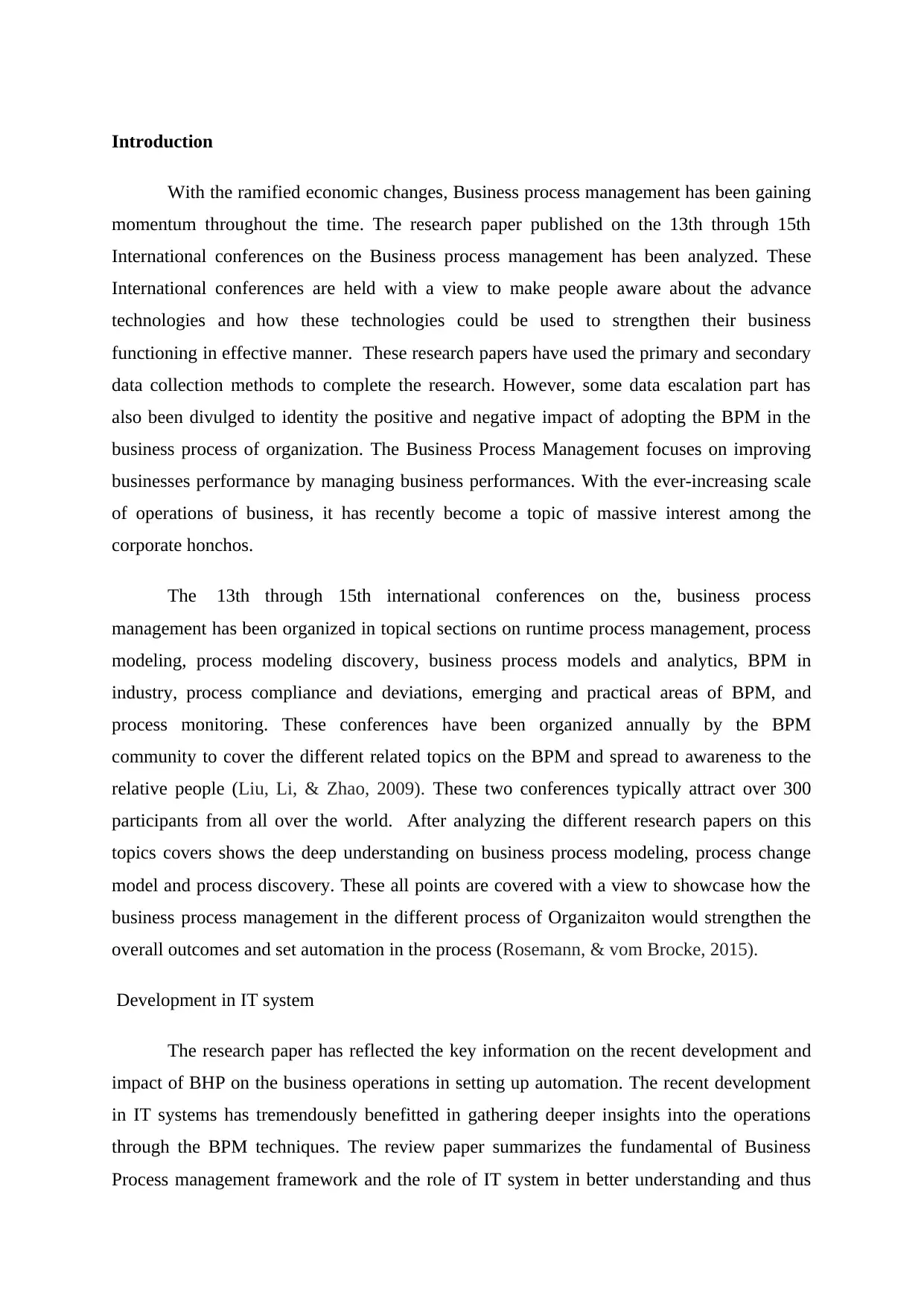
Introduction
With the ramified economic changes, Business process management has been gaining
momentum throughout the time. The research paper published on the 13th through 15th
International conferences on the Business process management has been analyzed. These
International conferences are held with a view to make people aware about the advance
technologies and how these technologies could be used to strengthen their business
functioning in effective manner. These research papers have used the primary and secondary
data collection methods to complete the research. However, some data escalation part has
also been divulged to identity the positive and negative impact of adopting the BPM in the
business process of organization. The Business Process Management focuses on improving
businesses performance by managing business performances. With the ever-increasing scale
of operations of business, it has recently become a topic of massive interest among the
corporate honchos.
The 13th through 15th international conferences on the, business process
management has been organized in topical sections on runtime process management, process
modeling, process modeling discovery, business process models and analytics, BPM in
industry, process compliance and deviations, emerging and practical areas of BPM, and
process monitoring. These conferences have been organized annually by the BPM
community to cover the different related topics on the BPM and spread to awareness to the
relative people (Liu, Li, & Zhao, 2009). These two conferences typically attract over 300
participants from all over the world. After analyzing the different research papers on this
topics covers shows the deep understanding on business process modeling, process change
model and process discovery. These all points are covered with a view to showcase how the
business process management in the different process of Organizaiton would strengthen the
overall outcomes and set automation in the process (Rosemann, & vom Brocke, 2015).
Development in IT system
The research paper has reflected the key information on the recent development and
impact of BHP on the business operations in setting up automation. The recent development
in IT systems has tremendously benefitted in gathering deeper insights into the operations
through the BPM techniques. The review paper summarizes the fundamental of Business
Process management framework and the role of IT system in better understanding and thus
With the ramified economic changes, Business process management has been gaining
momentum throughout the time. The research paper published on the 13th through 15th
International conferences on the Business process management has been analyzed. These
International conferences are held with a view to make people aware about the advance
technologies and how these technologies could be used to strengthen their business
functioning in effective manner. These research papers have used the primary and secondary
data collection methods to complete the research. However, some data escalation part has
also been divulged to identity the positive and negative impact of adopting the BPM in the
business process of organization. The Business Process Management focuses on improving
businesses performance by managing business performances. With the ever-increasing scale
of operations of business, it has recently become a topic of massive interest among the
corporate honchos.
The 13th through 15th international conferences on the, business process
management has been organized in topical sections on runtime process management, process
modeling, process modeling discovery, business process models and analytics, BPM in
industry, process compliance and deviations, emerging and practical areas of BPM, and
process monitoring. These conferences have been organized annually by the BPM
community to cover the different related topics on the BPM and spread to awareness to the
relative people (Liu, Li, & Zhao, 2009). These two conferences typically attract over 300
participants from all over the world. After analyzing the different research papers on this
topics covers shows the deep understanding on business process modeling, process change
model and process discovery. These all points are covered with a view to showcase how the
business process management in the different process of Organizaiton would strengthen the
overall outcomes and set automation in the process (Rosemann, & vom Brocke, 2015).
Development in IT system
The research paper has reflected the key information on the recent development and
impact of BHP on the business operations in setting up automation. The recent development
in IT systems has tremendously benefitted in gathering deeper insights into the operations
through the BPM techniques. The review paper summarizes the fundamental of Business
Process management framework and the role of IT system in better understanding and thus
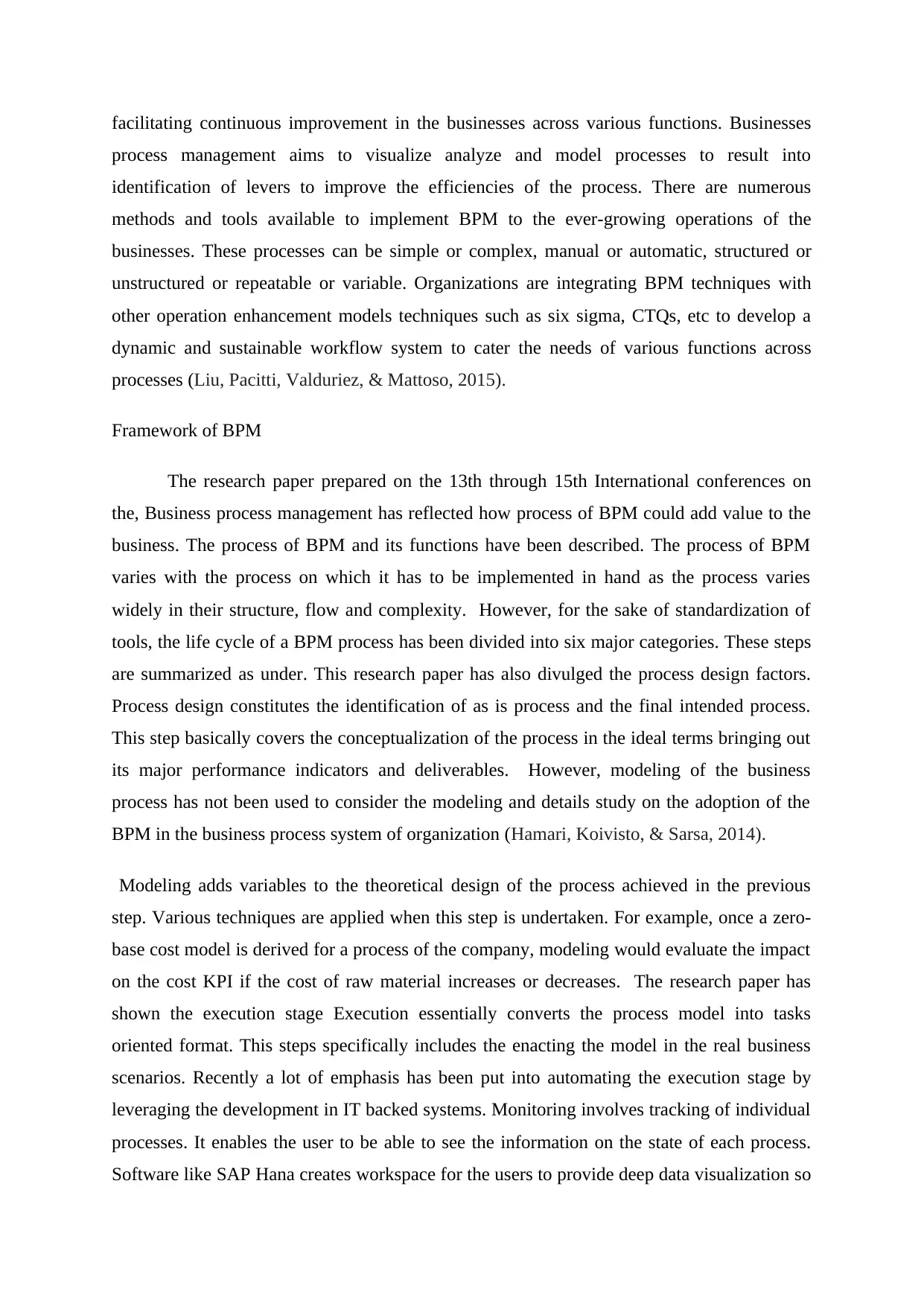
facilitating continuous improvement in the businesses across various functions. Businesses
process management aims to visualize analyze and model processes to result into
identification of levers to improve the efficiencies of the process. There are numerous
methods and tools available to implement BPM to the ever-growing operations of the
businesses. These processes can be simple or complex, manual or automatic, structured or
unstructured or repeatable or variable. Organizations are integrating BPM techniques with
other operation enhancement models techniques such as six sigma, CTQs, etc to develop a
dynamic and sustainable workflow system to cater the needs of various functions across
processes (Liu, Pacitti, Valduriez, & Mattoso, 2015).
Framework of BPM
The research paper prepared on the 13th through 15th International conferences on
the, Business process management has reflected how process of BPM could add value to the
business. The process of BPM and its functions have been described. The process of BPM
varies with the process on which it has to be implemented in hand as the process varies
widely in their structure, flow and complexity. However, for the sake of standardization of
tools, the life cycle of a BPM process has been divided into six major categories. These steps
are summarized as under. This research paper has also divulged the process design factors.
Process design constitutes the identification of as is process and the final intended process.
This step basically covers the conceptualization of the process in the ideal terms bringing out
its major performance indicators and deliverables. However, modeling of the business
process has not been used to consider the modeling and details study on the adoption of the
BPM in the business process system of organization (Hamari, Koivisto, & Sarsa, 2014).
Modeling adds variables to the theoretical design of the process achieved in the previous
step. Various techniques are applied when this step is undertaken. For example, once a zero-
base cost model is derived for a process of the company, modeling would evaluate the impact
on the cost KPI if the cost of raw material increases or decreases. The research paper has
shown the execution stage Execution essentially converts the process model into tasks
oriented format. This steps specifically includes the enacting the model in the real business
scenarios. Recently a lot of emphasis has been put into automating the execution stage by
leveraging the development in IT backed systems. Monitoring involves tracking of individual
processes. It enables the user to be able to see the information on the state of each process.
Software like SAP Hana creates workspace for the users to provide deep data visualization so
process management aims to visualize analyze and model processes to result into
identification of levers to improve the efficiencies of the process. There are numerous
methods and tools available to implement BPM to the ever-growing operations of the
businesses. These processes can be simple or complex, manual or automatic, structured or
unstructured or repeatable or variable. Organizations are integrating BPM techniques with
other operation enhancement models techniques such as six sigma, CTQs, etc to develop a
dynamic and sustainable workflow system to cater the needs of various functions across
processes (Liu, Pacitti, Valduriez, & Mattoso, 2015).
Framework of BPM
The research paper prepared on the 13th through 15th International conferences on
the, Business process management has reflected how process of BPM could add value to the
business. The process of BPM and its functions have been described. The process of BPM
varies with the process on which it has to be implemented in hand as the process varies
widely in their structure, flow and complexity. However, for the sake of standardization of
tools, the life cycle of a BPM process has been divided into six major categories. These steps
are summarized as under. This research paper has also divulged the process design factors.
Process design constitutes the identification of as is process and the final intended process.
This step basically covers the conceptualization of the process in the ideal terms bringing out
its major performance indicators and deliverables. However, modeling of the business
process has not been used to consider the modeling and details study on the adoption of the
BPM in the business process system of organization (Hamari, Koivisto, & Sarsa, 2014).
Modeling adds variables to the theoretical design of the process achieved in the previous
step. Various techniques are applied when this step is undertaken. For example, once a zero-
base cost model is derived for a process of the company, modeling would evaluate the impact
on the cost KPI if the cost of raw material increases or decreases. The research paper has
shown the execution stage Execution essentially converts the process model into tasks
oriented format. This steps specifically includes the enacting the model in the real business
scenarios. Recently a lot of emphasis has been put into automating the execution stage by
leveraging the development in IT backed systems. Monitoring involves tracking of individual
processes. It enables the user to be able to see the information on the state of each process.
Software like SAP Hana creates workspace for the users to provide deep data visualization so
⊘ This is a preview!⊘
Do you want full access?
Subscribe today to unlock all pages.

Trusted by 1+ million students worldwide
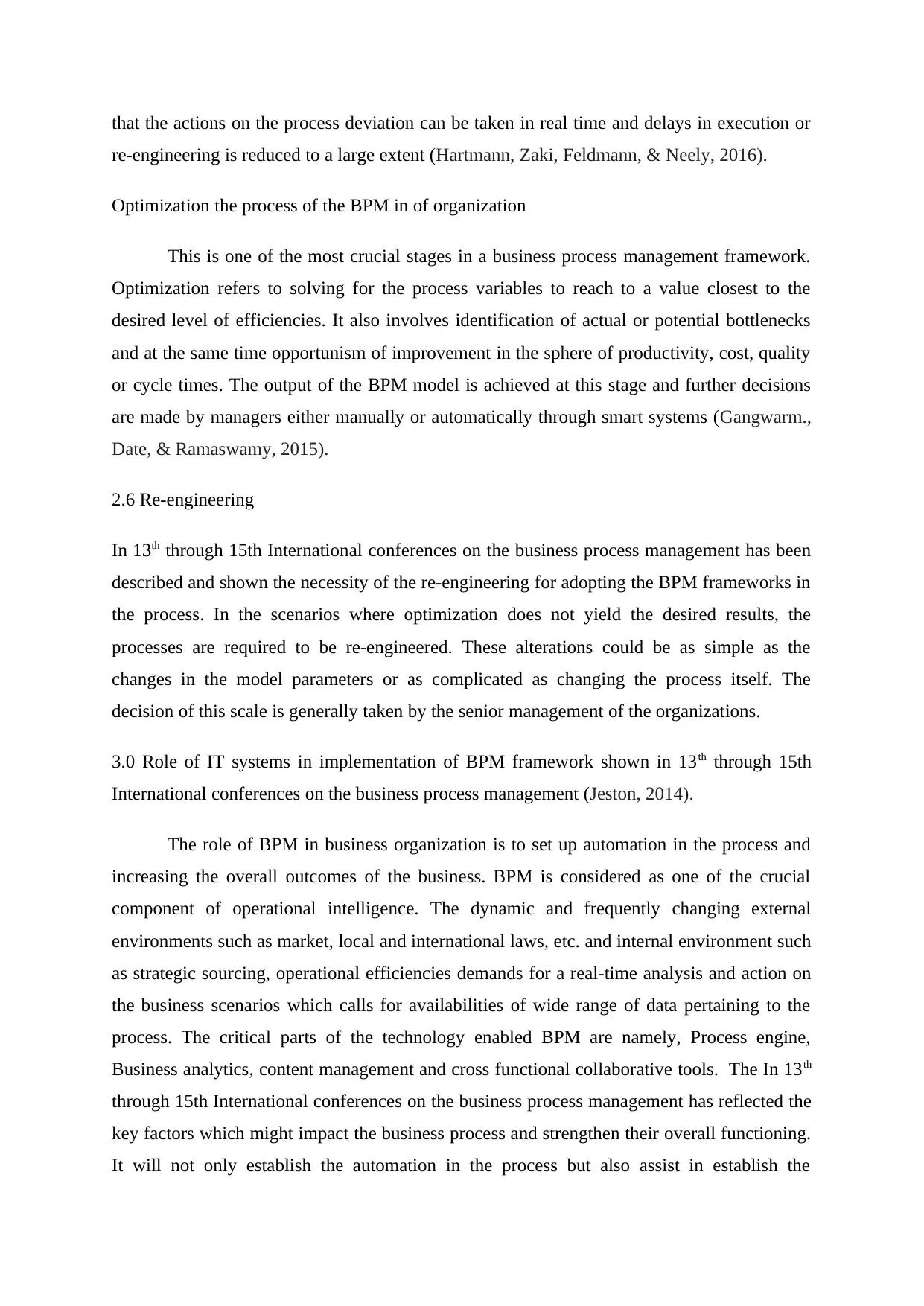
that the actions on the process deviation can be taken in real time and delays in execution or
re-engineering is reduced to a large extent (Hartmann, Zaki, Feldmann, & Neely, 2016).
Optimization the process of the BPM in of organization
This is one of the most crucial stages in a business process management framework.
Optimization refers to solving for the process variables to reach to a value closest to the
desired level of efficiencies. It also involves identification of actual or potential bottlenecks
and at the same time opportunism of improvement in the sphere of productivity, cost, quality
or cycle times. The output of the BPM model is achieved at this stage and further decisions
are made by managers either manually or automatically through smart systems (Gangwarm.,
Date, & Ramaswamy, 2015).
2.6 Re-engineering
In 13th through 15th International conferences on the business process management has been
described and shown the necessity of the re-engineering for adopting the BPM frameworks in
the process. In the scenarios where optimization does not yield the desired results, the
processes are required to be re-engineered. These alterations could be as simple as the
changes in the model parameters or as complicated as changing the process itself. The
decision of this scale is generally taken by the senior management of the organizations.
3.0 Role of IT systems in implementation of BPM framework shown in 13th through 15th
International conferences on the business process management (Jeston, 2014).
The role of BPM in business organization is to set up automation in the process and
increasing the overall outcomes of the business. BPM is considered as one of the crucial
component of operational intelligence. The dynamic and frequently changing external
environments such as market, local and international laws, etc. and internal environment such
as strategic sourcing, operational efficiencies demands for a real-time analysis and action on
the business scenarios which calls for availabilities of wide range of data pertaining to the
process. The critical parts of the technology enabled BPM are namely, Process engine,
Business analytics, content management and cross functional collaborative tools. The In 13th
through 15th International conferences on the business process management has reflected the
key factors which might impact the business process and strengthen their overall functioning.
It will not only establish the automation in the process but also assist in establish the
re-engineering is reduced to a large extent (Hartmann, Zaki, Feldmann, & Neely, 2016).
Optimization the process of the BPM in of organization
This is one of the most crucial stages in a business process management framework.
Optimization refers to solving for the process variables to reach to a value closest to the
desired level of efficiencies. It also involves identification of actual or potential bottlenecks
and at the same time opportunism of improvement in the sphere of productivity, cost, quality
or cycle times. The output of the BPM model is achieved at this stage and further decisions
are made by managers either manually or automatically through smart systems (Gangwarm.,
Date, & Ramaswamy, 2015).
2.6 Re-engineering
In 13th through 15th International conferences on the business process management has been
described and shown the necessity of the re-engineering for adopting the BPM frameworks in
the process. In the scenarios where optimization does not yield the desired results, the
processes are required to be re-engineered. These alterations could be as simple as the
changes in the model parameters or as complicated as changing the process itself. The
decision of this scale is generally taken by the senior management of the organizations.
3.0 Role of IT systems in implementation of BPM framework shown in 13th through 15th
International conferences on the business process management (Jeston, 2014).
The role of BPM in business organization is to set up automation in the process and
increasing the overall outcomes of the business. BPM is considered as one of the crucial
component of operational intelligence. The dynamic and frequently changing external
environments such as market, local and international laws, etc. and internal environment such
as strategic sourcing, operational efficiencies demands for a real-time analysis and action on
the business scenarios which calls for availabilities of wide range of data pertaining to the
process. The critical parts of the technology enabled BPM are namely, Process engine,
Business analytics, content management and cross functional collaborative tools. The In 13th
through 15th International conferences on the business process management has reflected the
key factors which might impact the business process and strengthen their overall functioning.
It will not only establish the automation in the process but also assist in establish the
Paraphrase This Document
Need a fresh take? Get an instant paraphrase of this document with our AI Paraphraser
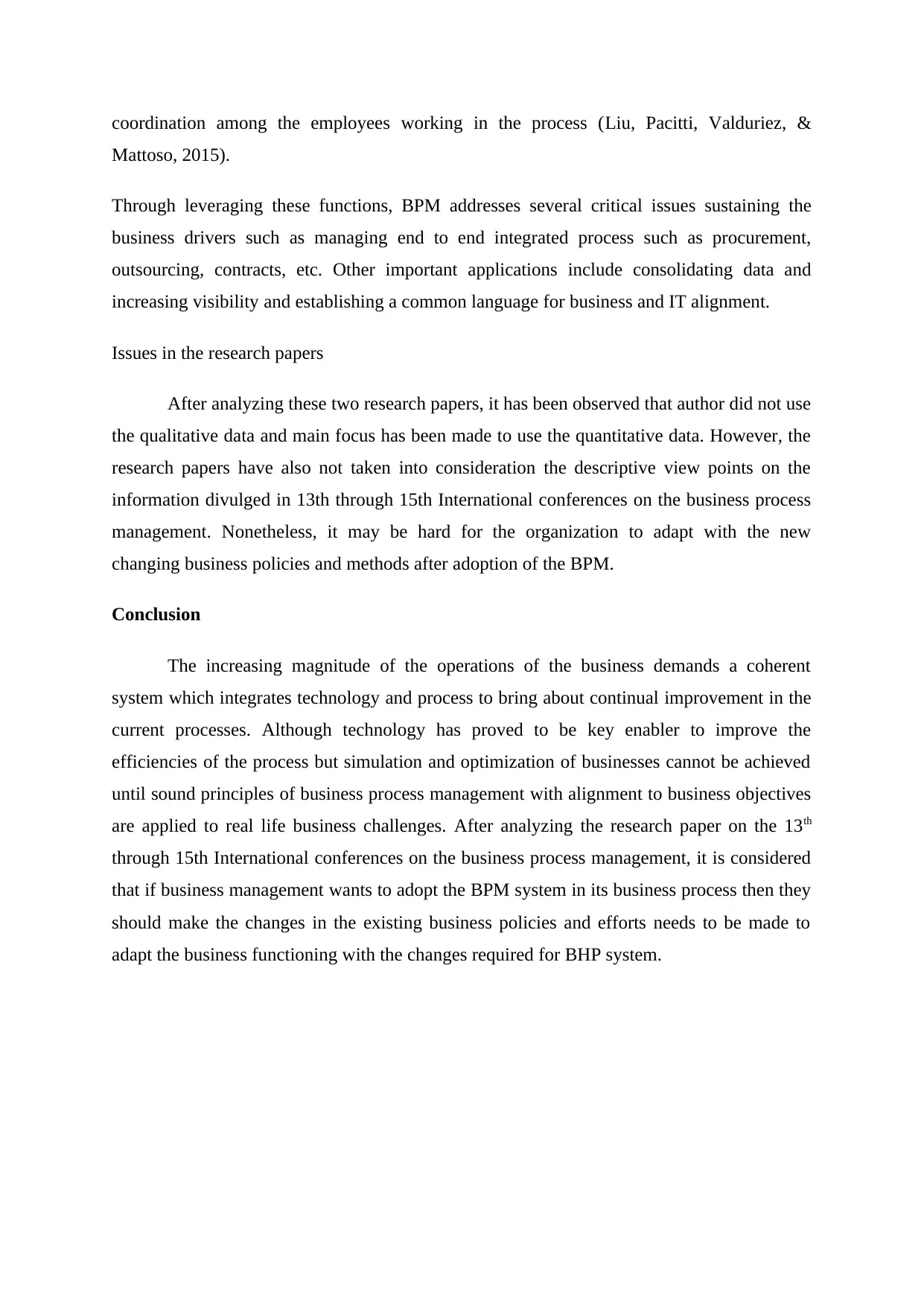
coordination among the employees working in the process (Liu, Pacitti, Valduriez, &
Mattoso, 2015).
Through leveraging these functions, BPM addresses several critical issues sustaining the
business drivers such as managing end to end integrated process such as procurement,
outsourcing, contracts, etc. Other important applications include consolidating data and
increasing visibility and establishing a common language for business and IT alignment.
Issues in the research papers
After analyzing these two research papers, it has been observed that author did not use
the qualitative data and main focus has been made to use the quantitative data. However, the
research papers have also not taken into consideration the descriptive view points on the
information divulged in 13th through 15th International conferences on the business process
management. Nonetheless, it may be hard for the organization to adapt with the new
changing business policies and methods after adoption of the BPM.
Conclusion
The increasing magnitude of the operations of the business demands a coherent
system which integrates technology and process to bring about continual improvement in the
current processes. Although technology has proved to be key enabler to improve the
efficiencies of the process but simulation and optimization of businesses cannot be achieved
until sound principles of business process management with alignment to business objectives
are applied to real life business challenges. After analyzing the research paper on the 13th
through 15th International conferences on the business process management, it is considered
that if business management wants to adopt the BPM system in its business process then they
should make the changes in the existing business policies and efforts needs to be made to
adapt the business functioning with the changes required for BHP system.
Mattoso, 2015).
Through leveraging these functions, BPM addresses several critical issues sustaining the
business drivers such as managing end to end integrated process such as procurement,
outsourcing, contracts, etc. Other important applications include consolidating data and
increasing visibility and establishing a common language for business and IT alignment.
Issues in the research papers
After analyzing these two research papers, it has been observed that author did not use
the qualitative data and main focus has been made to use the quantitative data. However, the
research papers have also not taken into consideration the descriptive view points on the
information divulged in 13th through 15th International conferences on the business process
management. Nonetheless, it may be hard for the organization to adapt with the new
changing business policies and methods after adoption of the BPM.
Conclusion
The increasing magnitude of the operations of the business demands a coherent
system which integrates technology and process to bring about continual improvement in the
current processes. Although technology has proved to be key enabler to improve the
efficiencies of the process but simulation and optimization of businesses cannot be achieved
until sound principles of business process management with alignment to business objectives
are applied to real life business challenges. After analyzing the research paper on the 13th
through 15th International conferences on the business process management, it is considered
that if business management wants to adopt the BPM system in its business process then they
should make the changes in the existing business policies and efforts needs to be made to
adapt the business functioning with the changes required for BHP system.
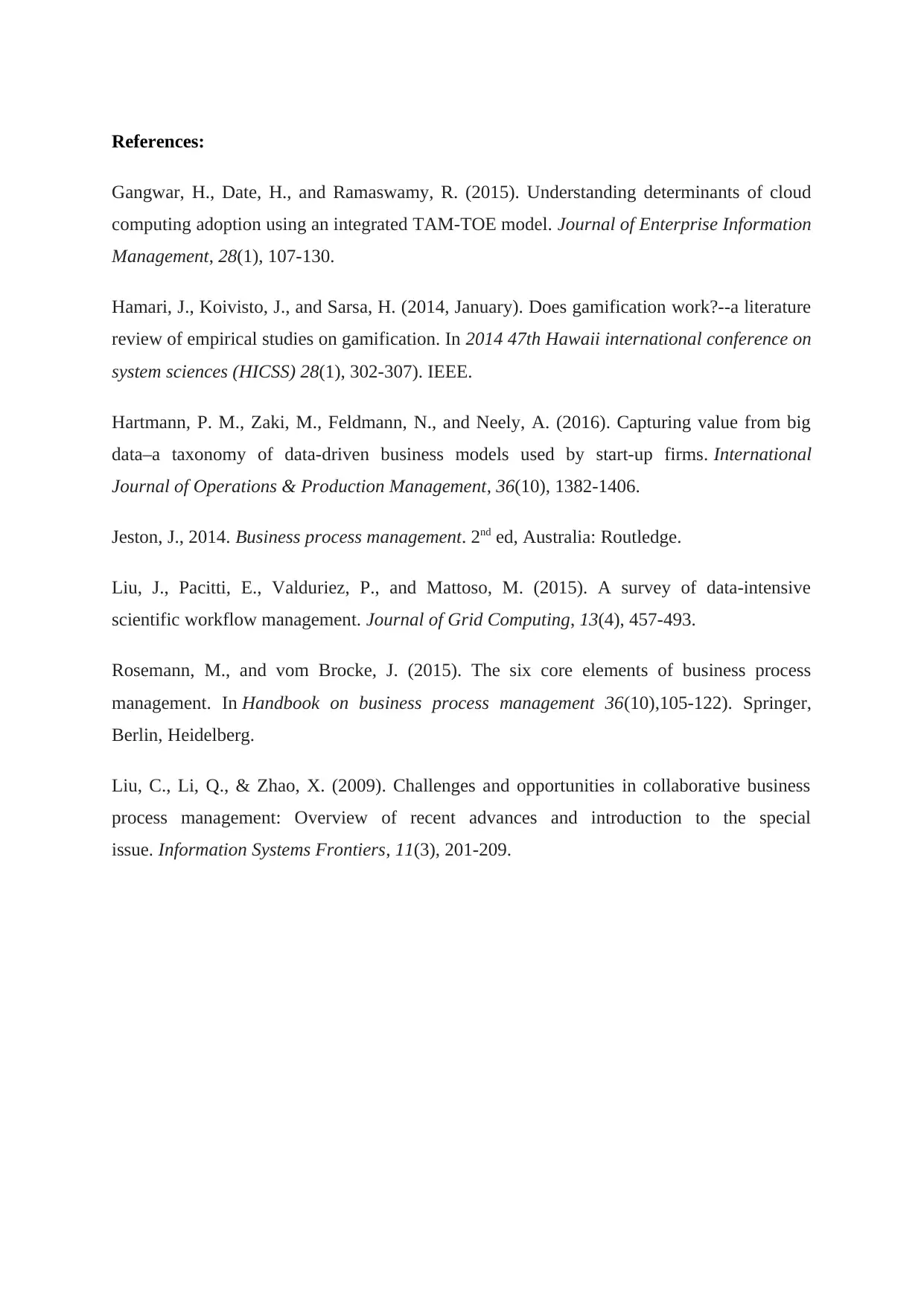
References:
Gangwar, H., Date, H., and Ramaswamy, R. (2015). Understanding determinants of cloud
computing adoption using an integrated TAM-TOE model. Journal of Enterprise Information
Management, 28(1), 107-130.
Hamari, J., Koivisto, J., and Sarsa, H. (2014, January). Does gamification work?--a literature
review of empirical studies on gamification. In 2014 47th Hawaii international conference on
system sciences (HICSS) 28(1), 302-307). IEEE.
Hartmann, P. M., Zaki, M., Feldmann, N., and Neely, A. (2016). Capturing value from big
data–a taxonomy of data-driven business models used by start-up firms. International
Journal of Operations & Production Management, 36(10), 1382-1406.
Jeston, J., 2014. Business process management. 2nd ed, Australia: Routledge.
Liu, J., Pacitti, E., Valduriez, P., and Mattoso, M. (2015). A survey of data-intensive
scientific workflow management. Journal of Grid Computing, 13(4), 457-493.
Rosemann, M., and vom Brocke, J. (2015). The six core elements of business process
management. In Handbook on business process management 36(10),105-122). Springer,
Berlin, Heidelberg.
Liu, C., Li, Q., & Zhao, X. (2009). Challenges and opportunities in collaborative business
process management: Overview of recent advances and introduction to the special
issue. Information Systems Frontiers, 11(3), 201-209.
Gangwar, H., Date, H., and Ramaswamy, R. (2015). Understanding determinants of cloud
computing adoption using an integrated TAM-TOE model. Journal of Enterprise Information
Management, 28(1), 107-130.
Hamari, J., Koivisto, J., and Sarsa, H. (2014, January). Does gamification work?--a literature
review of empirical studies on gamification. In 2014 47th Hawaii international conference on
system sciences (HICSS) 28(1), 302-307). IEEE.
Hartmann, P. M., Zaki, M., Feldmann, N., and Neely, A. (2016). Capturing value from big
data–a taxonomy of data-driven business models used by start-up firms. International
Journal of Operations & Production Management, 36(10), 1382-1406.
Jeston, J., 2014. Business process management. 2nd ed, Australia: Routledge.
Liu, J., Pacitti, E., Valduriez, P., and Mattoso, M. (2015). A survey of data-intensive
scientific workflow management. Journal of Grid Computing, 13(4), 457-493.
Rosemann, M., and vom Brocke, J. (2015). The six core elements of business process
management. In Handbook on business process management 36(10),105-122). Springer,
Berlin, Heidelberg.
Liu, C., Li, Q., & Zhao, X. (2009). Challenges and opportunities in collaborative business
process management: Overview of recent advances and introduction to the special
issue. Information Systems Frontiers, 11(3), 201-209.
⊘ This is a preview!⊘
Do you want full access?
Subscribe today to unlock all pages.

Trusted by 1+ million students worldwide
1 out of 6
Related Documents
Your All-in-One AI-Powered Toolkit for Academic Success.
+13062052269
info@desklib.com
Available 24*7 on WhatsApp / Email
![[object Object]](/_next/static/media/star-bottom.7253800d.svg)
Unlock your academic potential
Copyright © 2020–2025 A2Z Services. All Rights Reserved. Developed and managed by ZUCOL.




